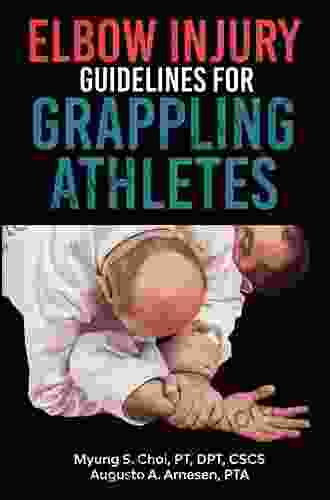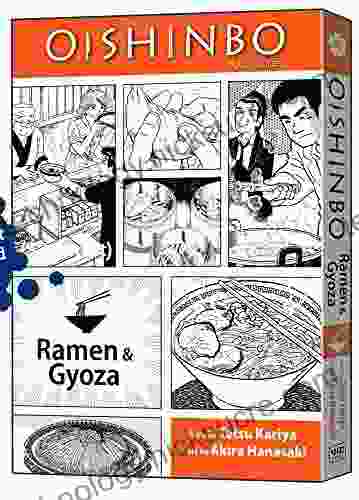Elbow Injury Guidelines For Grappling Athletes: A Comprehensive Guide

Elbow injuries are common among grappling athletes, and can be caused by a variety of factors, including overuse, trauma, and improper technique. This guide will provide you with the information you need to prevent, recognize, and treat elbow injuries.
4.6 out of 5
| Language | : | English |
| File size | : | 6490 KB |
| Text-to-Speech | : | Enabled |
| Enhanced typesetting | : | Enabled |
| X-Ray | : | Enabled |
| Word Wise | : | Enabled |
| Lending | : | Enabled |
| Screen Reader | : | Supported |
| Print length | : | 270 pages |
| Paperback | : | 64 pages |
| Item Weight | : | 3.53 ounces |
| Dimensions | : | 6 x 0.13 x 9 inches |
Anatomy of the Elbow
The elbow is a complex joint that connects the upper arm (humerus) to the forearm (radius and ulna). The elbow joint is made up of three bones, three ligaments, and several muscles.
The bones of the elbow are the humerus, radius, and ulna. The humerus is the long bone of the upper arm. The radius and ulna are the two bones of the forearm.
The ligaments of the elbow are the medial collateral ligament (MCL),lateral collateral ligament (LCL),and annular ligament. The MCL is located on the inside of the elbow and connects the humerus to the ulna. The LCL is located on the outside of the elbow and connects the humerus to the radius. The annular ligament surrounds the head of the radius and helps to hold it in place.
The muscles of the elbow are the biceps brachii, triceps brachii, brachialis, and brachioradialis. The biceps brachii is located on the front of the upper arm and helps to flex the elbow. The triceps brachii is located on the back of the upper arm and helps to extend the elbow. The brachialis is located on the inside of the upper arm and helps to flex the elbow. The brachioradialis is located on the outside of the forearm and helps to flex the elbow and pronate the forearm.
Types of Elbow Injuries
There are a variety of different elbow injuries that can occur in grappling athletes. The most common types of elbow injuries include:
* Medial collateral ligament (MCL) injuries: MCL injuries are the most common type of elbow injury in grappling athletes. MCL injuries occur when the MCL is stretched or torn. This can happen when the elbow is forced into valgus (bending inward) or when a force is applied to the outside of the elbow. * Lateral collateral ligament (LCL) injuries: LCL injuries are less common than MCL injuries. LCL injuries occur when the LCL is stretched or torn. This can happen when the elbow is forced into varus (bending outward) or when a force is applied to the inside of the elbow. * Ulnar nerve entrapment: Ulnar nerve entrapment occurs when the ulnar nerve is compressed in the elbow. This can cause pain, numbness, and weakness in the hand and forearm. * Elbow bursitis: Elbow bursitis is a condition that occurs when the bursa (a fluid-filled sac) in the elbow becomes inflamed. This can cause pain, swelling, and tenderness in the elbow. * Olecranon stress fracture: An olecranon stress fracture is a small crack in the olecranon (the bony point at the back of the elbow). This can occur in athletes who perform repetitive elbow movements, such as grappling.
Causes of Elbow Injuries
Elbow injuries can be caused by a variety of factors, including:
* Overuse: Overuse is the most common cause of elbow injuries in grappling athletes. Overuse can occur when an athlete performs repetitive elbow movements, such as grappling, without giving the elbow adequate time to rest. * Trauma: Trauma is another common cause of elbow injuries in grappling athletes. Trauma can occur when an athlete falls on their elbow, is struck by an opponent, or is caught in a submission hold. * Improper technique: Improper technique can also lead to elbow injuries in grappling athletes. For example, using an incorrect grip when grappling can put excessive stress on the elbow joint.
Symptoms of Elbow Injuries
The symptoms of elbow injuries can vary depending on the type of injury. However, some common symptoms of elbow injuries include:
* Pain * Swelling * Tenderness * Stiffness * Loss of range of motion * Numbness or tingling in the hand or forearm
Diagnosis of Elbow Injuries
If you are experiencing any of the symptoms of elbow injury, it is important to see a doctor for diagnosis. Your doctor will perform a physical examination and may order imaging tests, such as an X-ray or MRI, to confirm the diagnosis.
Treatment of Elbow Injuries
Treatment for elbow injuries varies depending on the type and severity of the injury. Treatment options may include:
* Rest: Rest is essential for healing elbow injuries. Your doctor may recommend that you avoid activities that aggravate your injury. * Ice: Ice can help to reduce pain and swelling. Apply ice to your elbow for 15-20 minutes at a time, several times a day. * Compression: Compression can help to reduce swelling. Wrap your elbow with an elastic bandage. * Elevation: Elevating your elbow above your heart can help to reduce swelling. * Medication: Over-the-counter pain relievers, such as ibuprofen or acetaminophen, can help to reduce pain. * Physical therapy: Physical therapy can help to improve range of motion, strength, and stability in the elbow. * Surgery: Surgery may be necessary to repair a severe elbow injury.
Prevention of Elbow Injuries
There are a number of things that you can do to prevent elbow injuries, including:
* Warm up properly before grappling: Warming up the muscles around the elbow can help to prevent injuries. * Use proper technique when grappling: Using incorrect technique can put excessive stress on the elbow joint. * Strengthen the muscles around the elbow: Strong muscles can help to stabilize the elbow joint and prevent injuries. * Stretch the muscles around the elbow: Stretching the muscles around the elbow can help to improve range of motion and prevent injuries. * Listen to your body: If you experience any pain in your elbow, stop grappling and rest.
Elbow injuries are common among grappling athletes, but they can be prevented, recognized, and treated. By following the guidelines in this article, you can reduce your risk of elbow injury and stay on the mat.
4.6 out of 5
| Language | : | English |
| File size | : | 6490 KB |
| Text-to-Speech | : | Enabled |
| Enhanced typesetting | : | Enabled |
| X-Ray | : | Enabled |
| Word Wise | : | Enabled |
| Lending | : | Enabled |
| Screen Reader | : | Supported |
| Print length | : | 270 pages |
| Paperback | : | 64 pages |
| Item Weight | : | 3.53 ounces |
| Dimensions | : | 6 x 0.13 x 9 inches |
Do you want to contribute by writing guest posts on this blog?
Please contact us and send us a resume of previous articles that you have written.
 Fiction
Fiction Non Fiction
Non Fiction Romance
Romance Mystery
Mystery Thriller
Thriller SciFi
SciFi Fantasy
Fantasy Horror
Horror Biography
Biography Selfhelp
Selfhelp Business
Business History
History Classics
Classics Poetry
Poetry Childrens
Childrens Young Adult
Young Adult Educational
Educational Cooking
Cooking Travel
Travel Lifestyle
Lifestyle Spirituality
Spirituality Health
Health Fitness
Fitness Technology
Technology Science
Science Arts
Arts Crafts
Crafts DIY
DIY Gardening
Gardening Petcare
Petcare Kevin Gallagher
Kevin Gallagher Douglas D Scott
Douglas D Scott Geza Vermes
Geza Vermes Peter Ross
Peter Ross John Thorne
John Thorne Titania Hardie
Titania Hardie Richard Shotton
Richard Shotton James Suzman
James Suzman Eric Zandona
Eric Zandona Darin Ingels
Darin Ingels Lonely Planet
Lonely Planet Jerry C Whitaker
Jerry C Whitaker Mark Golds
Mark Golds Aleksandr Anufriyev
Aleksandr Anufriyev Vasti Torres
Vasti Torres Phil Jarratt
Phil Jarratt Tim Moore
Tim Moore Marvin Harris
Marvin Harris Stormie Omartian
Stormie Omartian Martin Baldridge
Martin Baldridge P J Agness
P J Agness Mauricio Fau
Mauricio Fau Janie B Butts
Janie B Butts Mary Lynne Fernandez
Mary Lynne Fernandez Peter Collier
Peter Collier C C Hunter
C C Hunter Sarah Lynne Bowman
Sarah Lynne Bowman Suzie Sheehy
Suzie Sheehy Nate Silver
Nate Silver Scott Turansky
Scott Turansky Charlene L Edge
Charlene L Edge Anatoli Boukreev
Anatoli Boukreev J Richard Hackman
J Richard Hackman Danielle Tumminio Hansen
Danielle Tumminio Hansen Aaron Reynolds
Aaron Reynolds Alex Gillis
Alex Gillis L R Trovillion
L R Trovillion Anna Post
Anna Post Lyn Kelley
Lyn Kelley Mark Creasy
Mark Creasy Stephanie Ermenegild
Stephanie Ermenegild Janja Lalich
Janja Lalich Stephen K Hayes
Stephen K Hayes William R Short
William R Short Robert Dos Remedios
Robert Dos Remedios Rebecca Schrag Hershberg
Rebecca Schrag Hershberg Alexa Whitewolf
Alexa Whitewolf Sara Shepard
Sara Shepard Josh Bryant
Josh Bryant Ashton Cartwright
Ashton Cartwright Jerry C Zee
Jerry C Zee Derek Lundy
Derek Lundy Sheryl Buckland
Sheryl Buckland Aman Gupta
Aman Gupta Gordon Feinberg
Gordon Feinberg Catherine Crier
Catherine Crier Andrew Stellman
Andrew Stellman Jeana Jorgensen
Jeana Jorgensen John Stage
John Stage Fridtjof Nansen
Fridtjof Nansen Gabriel Levy
Gabriel Levy Elon Vidal
Elon Vidal Yannis Detorakis
Yannis Detorakis Leonhard Euler
Leonhard Euler Brett Cohen
Brett Cohen Eric R Kandel
Eric R Kandel Stanley Cohen
Stanley Cohen Peter Maguire
Peter Maguire John Boyette
John Boyette Brent Zwerneman
Brent Zwerneman Albert Rutherford
Albert Rutherford River
River Celia Hodent
Celia Hodent Jon Krakauer
Jon Krakauer Audra Fordin
Audra Fordin Shannon Jett
Shannon Jett Don Bendell
Don Bendell Richard Cole
Richard Cole Ellen Snortland
Ellen Snortland Greg Michaelson
Greg Michaelson Christina Riggs
Christina Riggs Pekka Louhiala
Pekka Louhiala David G Kleinbaum
David G Kleinbaum Kent David Kelly
Kent David Kelly Patrick F Mcmanus
Patrick F Mcmanus Alex J Packer
Alex J Packer Howard Schor
Howard Schor Alex Pentland
Alex Pentland Winona Guo
Winona Guo Darl Kuhn
Darl Kuhn Bob Palmer
Bob Palmer Andrew Zerling
Andrew Zerling Daniel Pautrat
Daniel Pautrat Heather Dale
Heather Dale Michael Terry
Michael Terry Aleister Crowley
Aleister Crowley Chella Man
Chella Man Jennifer Cohen Harper
Jennifer Cohen Harper Steve Flink
Steve Flink Pascal Boyer
Pascal Boyer Lara S Ormiston
Lara S Ormiston Martha Sears
Martha Sears Elizabeth White
Elizabeth White Suzanne Collins
Suzanne Collins David Shinar
David Shinar Michael Thompson
Michael Thompson Angelo Tropea
Angelo Tropea Tracy Brown Collins
Tracy Brown Collins Laura Morton Rd
Laura Morton Rd Nate Orlowek
Nate Orlowek Karen Casey
Karen Casey Aubrey Sherman
Aubrey Sherman Alex Morgan
Alex Morgan Erin Bowe
Erin Bowe Alex Hibbert
Alex Hibbert Wallace Wang
Wallace Wang Sam Jalloh
Sam Jalloh James Patterson
James Patterson Ari Mennander
Ari Mennander Barbara Ehrenreich
Barbara Ehrenreich Dan Jacob
Dan Jacob Aaron Robinet
Aaron Robinet Jennifer Kramer
Jennifer Kramer Bruce Johnson
Bruce Johnson Kalynn Bayron
Kalynn Bayron Jennet Conant
Jennet Conant Jenny Mackay
Jenny Mackay Richard D Easton
Richard D Easton Paul Volponi
Paul Volponi Willard A Palmer
Willard A Palmer Duncan Butchart
Duncan Butchart Earl Swift
Earl Swift Hal Higdon
Hal Higdon Simon Monk
Simon Monk Julia Wertz
Julia Wertz Larry Pardey
Larry Pardey Thomas Cahill
Thomas Cahill Luis Angel Echeverria
Luis Angel Echeverria Wesley Bernardini
Wesley Bernardini Michele Gelfand
Michele Gelfand Alex Riley
Alex Riley Albert J Raboteau
Albert J Raboteau Amber Lia
Amber Lia Kathleen Mcmillan
Kathleen Mcmillan K D Hume
K D Hume Pamela K Lamb
Pamela K Lamb Denny Matthews
Denny Matthews L Michele Issel
L Michele Issel Alistair Moffat
Alistair Moffat Kingsley Amis
Kingsley Amis C J Brown
C J Brown Dan Purser Md
Dan Purser Md Loriann Oberlin
Loriann Oberlin Theodore X O Connell
Theodore X O Connell Rachael Ray
Rachael Ray Sarah Ockwell Smith
Sarah Ockwell Smith Alex Reinhart
Alex Reinhart George E Vaillant
George E Vaillant Gail M Nelson
Gail M Nelson Anne Bogel
Anne Bogel Alexandra Bracken
Alexandra Bracken Arieh Ben Naim
Arieh Ben Naim Austin Murphy
Austin Murphy Carla Naumburg
Carla Naumburg Megan Carle
Megan Carle Stephan Martin
Stephan Martin Vimla L Patel
Vimla L Patel Dan Gookin
Dan Gookin Alex Hunter
Alex Hunter Kristin Gambaccini
Kristin Gambaccini Duncan Wells
Duncan Wells Emma Hansen
Emma Hansen Teresa Denton
Teresa Denton Dr Yvonne S Thornton
Dr Yvonne S Thornton Mark Sisson
Mark Sisson Albert W A Schmid
Albert W A Schmid Gary Nicol
Gary Nicol Chip Heath
Chip Heath Soo Kim Abboud
Soo Kim Abboud Devin Devasquez
Devin Devasquez J C Herz
J C Herz Harold Klemp
Harold Klemp Alexander L Co
Alexander L Co Alexander Jones
Alexander Jones F T Lukens
F T Lukens Sarah Stewart Johnson
Sarah Stewart Johnson Peter J Feibelman
Peter J Feibelman David Farrier
David Farrier Game Spark
Game Spark Alberto Villoldo
Alberto Villoldo Leigh Hatts
Leigh Hatts Eric Mason
Eric Mason George Ehrenhaft
George Ehrenhaft Beverleigh H Piepers
Beverleigh H Piepers Celeste Headlee
Celeste Headlee Ben Malisow
Ben Malisow Jim Hynes
Jim Hynes Mark Warren
Mark Warren Victor Davis Hanson
Victor Davis Hanson Deborah L Davis
Deborah L Davis David Thomas
David Thomas Matt Johanson
Matt Johanson Lynn Alley
Lynn Alley Walter Gretzky
Walter Gretzky Daniel L Everett
Daniel L Everett Milan Yerkovich
Milan Yerkovich Tony Roig
Tony Roig Alex Bellos
Alex Bellos R K Gupta
R K Gupta Scott L Smith
Scott L Smith Itzhak Bentov
Itzhak Bentov Sally Moomaw
Sally Moomaw Roseanne A Brown
Roseanne A Brown Alda Sigmundsdottir
Alda Sigmundsdottir Garth Nix
Garth Nix Kyle Rohrig
Kyle Rohrig Scott Fratcher
Scott Fratcher Gary Coleman
Gary Coleman Otto Kroeger
Otto Kroeger Russ Unger
Russ Unger Ken Schultz
Ken Schultz Eric Enge
Eric Enge Alex Itsios
Alex Itsios Katie Edwards
Katie Edwards Namita Prasad
Namita Prasad David Leadbetter
David Leadbetter George Marshall
George Marshall Phil Keith
Phil Keith Robbie Couch
Robbie Couch Travis Eliot
Travis Eliot David L Demets
David L Demets Jennifer Estep
Jennifer Estep Howard Carter
Howard Carter Albert Hofmann
Albert Hofmann Elena Zotova
Elena Zotova Holly Black
Holly Black Sarah Franklin
Sarah Franklin Sabbithry Persad Mba
Sabbithry Persad Mba Alfie Kohn
Alfie Kohn G Blake Meike
G Blake Meike Robert Spindler
Robert Spindler Idan Ravin
Idan Ravin Alexander Ferrauti
Alexander Ferrauti Albert Marrin
Albert Marrin Peter Galison
Peter Galison Jimmy Connors
Jimmy Connors Jacqueline Tourville
Jacqueline Tourville Julie Berry
Julie Berry Bertus Engelbrecht
Bertus Engelbrecht Alberta Hawse
Alberta Hawse Matthew Johnson
Matthew Johnson Hadley Wickham
Hadley Wickham Marilynn Hughes
Marilynn Hughes David Borgenicht
David Borgenicht Oluwaseun Ajayi
Oluwaseun Ajayi Albert Ellis
Albert Ellis Christie Cognevich
Christie Cognevich Linda Egenes
Linda Egenes Jon B Gould
Jon B Gould Alex Polyakov
Alex Polyakov Roy Plotnick
Roy Plotnick John Quick
John Quick Ruth Minsky Sender
Ruth Minsky Sender Derrick Niederman
Derrick Niederman Mark Reed
Mark Reed Michael Steven
Michael Steven John Burroughs
John Burroughs Alex Guarnaschelli
Alex Guarnaschelli Margaret Rooke
Margaret Rooke Saunders Mac Lane
Saunders Mac Lane Lake E High
Lake E High Alex Light
Alex Light Ernest Hemingway
Ernest Hemingway Hiro Ainana
Hiro Ainana Janine Marsh
Janine Marsh Pedro Domingos
Pedro Domingos Alan Lightman
Alan Lightman Graham Hancock
Graham Hancock Gf Denehy
Gf Denehy Ralph Vacchiano
Ralph Vacchiano Steve Warner
Steve Warner Robert W Winters
Robert W Winters Alex Wade
Alex Wade Alexa Nicole Cucchiara
Alexa Nicole Cucchiara Daniel Shapiro
Daniel Shapiro Paul Trammell
Paul Trammell Richard Ronald
Richard Ronald Stan Utley
Stan Utley Anne Dachel
Anne Dachel Eli Burakian
Eli Burakian David N Myers
David N Myers Douglas Doman
Douglas Doman Alexander Bennett
Alexander Bennett Sally Huss
Sally Huss Rajesh K Naz
Rajesh K Naz Phil Pierce
Phil Pierce Brian Beffort
Brian Beffort Jennifer Boyle
Jennifer Boyle Gigi Georges
Gigi Georges Olivia Wildenstein
Olivia Wildenstein Joan Wulff
Joan Wulff Victoria Wilson
Victoria Wilson Alex Bezzerides
Alex Bezzerides Stephen Wilbers
Stephen Wilbers Suzanna Mcgee
Suzanna Mcgee Kevin Bales
Kevin Bales Deirdre Martin
Deirdre Martin Victoria Schwab
Victoria Schwab Scott Whitlock
Scott Whitlock Brad Borkan
Brad Borkan Alex Boese
Alex Boese Marian Dewane
Marian Dewane Tiffany Dionne
Tiffany Dionne Donnie Eichar
Donnie Eichar Gabriyell Sarom
Gabriyell Sarom Robert L Wolke
Robert L Wolke Cosmic Kids Publications
Cosmic Kids Publications Thomas Jaden
Thomas Jaden James Johonnot
James Johonnot Dr Rebecca Harwin
Dr Rebecca Harwin Todd Denault
Todd Denault Amy Newmark
Amy Newmark Lisa Manterfield
Lisa Manterfield Chris Englert
Chris Englert Tetsu Kariya
Tetsu Kariya Paul Sating
Paul Sating Glenn Rivers
Glenn Rivers Stephen R Lawhead
Stephen R Lawhead Jenna Gottlieb
Jenna Gottlieb Cary Nemeroff
Cary Nemeroff Ron Mckeefery
Ron Mckeefery Tim Cahill
Tim Cahill Chanice Lee
Chanice Lee Mia King
Mia King Will Hart
Will Hart Kieran Mccarthy
Kieran Mccarthy Evan F Moore
Evan F Moore Laura Eckert
Laura Eckert Rebecca Wilson
Rebecca Wilson Zach Davis
Zach Davis Olivier Doleuze
Olivier Doleuze Upgraded Brain
Upgraded Brain Alicia Ranoldo
Alicia Ranoldo Diana L Paxson
Diana L Paxson Brigid Kemmerer
Brigid Kemmerer Judy Dutton
Judy Dutton Nancy Silverton
Nancy Silverton Thomas Sowell
Thomas Sowell Michael Clary
Michael Clary Nancy Marie Brown
Nancy Marie Brown Georgiann Davis
Georgiann Davis Terry Marsh
Terry Marsh Lisa Silverman
Lisa Silverman Albert S Tarendash
Albert S Tarendash Ernest T Stringer
Ernest T Stringer Cecil B Hartley
Cecil B Hartley Saxon Andrew
Saxon Andrew Philip Wylie
Philip Wylie Alexander Clarke
Alexander Clarke Robert Penn
Robert Penn Richard M Foxx
Richard M Foxx Vanessa Van Edwards
Vanessa Van Edwards Thomas Huhti
Thomas Huhti Chuck Norris
Chuck Norris Elissa Wall
Elissa Wall Alejandro Portes
Alejandro Portes Peter Matthiessen
Peter Matthiessen Kristen Jane Anderson
Kristen Jane Anderson Nikki Nichols
Nikki Nichols Dipika Mukherjee
Dipika Mukherjee Alex Harris
Alex Harris Hannah V Holmes
Hannah V Holmes Sophie David
Sophie David Michael Digiacomo
Michael Digiacomo Jim Davidson
Jim Davidson Ash Perrin
Ash Perrin Katrina M Adams
Katrina M Adams Keith H Basso
Keith H Basso Patrick Alan Danaher
Patrick Alan Danaher Phyllis Good
Phyllis Good Sabine Hossenfelder
Sabine Hossenfelder Scott Kelly
Scott Kelly Jules Wake
Jules Wake Alexander Meyer
Alexander Meyer Qaiser Feroze
Qaiser Feroze Raj Kumar
Raj Kumar Rough Guides
Rough Guides Alfred P Rovai
Alfred P Rovai Genese Marie Sodikoff
Genese Marie Sodikoff Michael Sandler
Michael Sandler Phil Hanrahan
Phil Hanrahan Catherine Dawson
Catherine Dawson Gordon Rugg
Gordon Rugg Jeff Galloway
Jeff Galloway Alexander Boxer
Alexander Boxer Conn Iggulden
Conn Iggulden Steve Helling
Steve Helling Sam Sheridan
Sam Sheridan Fataniss Store
Fataniss Store Phil Gaimon
Phil Gaimon Chukwuma Eleodimuo
Chukwuma Eleodimuo Bill Haggerty
Bill Haggerty Brent Herrick
Brent Herrick Kathryn Purdie
Kathryn Purdie Alex Zimmerman
Alex Zimmerman Fiaz Rafiq
Fiaz Rafiq Sareen S Gropper
Sareen S Gropper Stephen L Sass
Stephen L Sass Moh Kolli Carnet
Moh Kolli Carnet S Kelley Harrell
S Kelley Harrell Robertson Tait
Robertson Tait Peter Brown
Peter Brown Molly Knox Ostertag
Molly Knox Ostertag Philip Ball
Philip Ball Taylor Harris
Taylor Harris Henrik Beyer
Henrik Beyer Jeremy Kubica
Jeremy Kubica Alex Banks
Alex Banks Kirsten Koza
Kirsten Koza W C Mcrae
W C Mcrae Stephon Alexander
Stephon Alexander Dennis R Helsel
Dennis R Helsel Alexander Mackenzie
Alexander Mackenzie Danielle Paige
Danielle Paige Ben Ainslie
Ben Ainslie Steve Bechtel
Steve Bechtel Michael Teitelbaum
Michael Teitelbaum Arshay Cooper
Arshay Cooper Robert Benson
Robert Benson Michele Filgate
Michele Filgate Sky Marsen
Sky Marsen John Kretschmer
John Kretschmer Julian B Barbour
Julian B Barbour Jacob Sannox
Jacob Sannox Linda White
Linda White Kortney Keisel
Kortney Keisel Jason R Rich
Jason R Rich Alex Johnson
Alex Johnson Fretta Reitzes
Fretta Reitzes Pittacus Lore
Pittacus Lore Alex Wolf
Alex Wolf Mary Ellen Hannibal
Mary Ellen Hannibal David N Schwartz
David N Schwartz Morgan Lyle
Morgan Lyle Alessandro Valerani
Alessandro Valerani Alexander Mccall Smith
Alexander Mccall Smith David J Chalmers
David J Chalmers Patrick Taylor
Patrick Taylor Alessio Mangoni
Alessio Mangoni Amanda Epperson
Amanda Epperson Yang Erche Namu
Yang Erche Namu Donald D Hoffman
Donald D Hoffman Jase Robertson
Jase Robertson Katherine Leigh
Katherine Leigh Caren Cooper
Caren Cooper Jennifer Van Allen
Jennifer Van Allen Kevin Mcaleer
Kevin Mcaleer Laura Pavlov
Laura Pavlov Don Pitcher
Don Pitcher Hannah Arendt
Hannah Arendt Alex Mars
Alex Mars Mine Dogucu
Mine Dogucu Alex J Gutman
Alex J Gutman Meredith Atwood
Meredith Atwood Kinsey Phifer
Kinsey Phifer Daniel Defoe
Daniel Defoe Diana Hopkins
Diana Hopkins Q S Khan
Q S Khan Scott Butler
Scott Butler Joe Nobody
Joe Nobody Margaret Willson
Margaret Willson
Light bulbAdvertise smarter! Our strategic ad space ensures maximum exposure. Reserve your spot today!

 Marcus BellHeavy Weather Sailing: The Ultimate Guide to Sailing Safely and Confidently...
Marcus BellHeavy Weather Sailing: The Ultimate Guide to Sailing Safely and Confidently... Nikolai GogolFollow ·4.4k
Nikolai GogolFollow ·4.4k Allen ParkerFollow ·15.2k
Allen ParkerFollow ·15.2k Reginald CoxFollow ·18.1k
Reginald CoxFollow ·18.1k Dalton FosterFollow ·14.9k
Dalton FosterFollow ·14.9k José SaramagoFollow ·8.1k
José SaramagoFollow ·8.1k Arthur Conan DoyleFollow ·15.5k
Arthur Conan DoyleFollow ·15.5k Roald DahlFollow ·13.8k
Roald DahlFollow ·13.8k Vic ParkerFollow ·17.3k
Vic ParkerFollow ·17.3k

 Jeffrey Cox
Jeffrey CoxEasy Recipes And Meal Plans For Healthy Pregnancy
Congratulations on...

 Andy Cole
Andy ColeDive into the Fiery Ordeal and Mockingjay's Rebellion: An...
: A Captivating Dystopian Saga The...

 Ernest Powell
Ernest PowellLore Alexandra Bracken: Unveiling the Mastermind Behind...
: In the vast expanse of contemporary...

 T.S. Eliot
T.S. EliotThe Story of the Invention of the Typewriter: 150 Years...
The typewriter, a...
4.6 out of 5
| Language | : | English |
| File size | : | 6490 KB |
| Text-to-Speech | : | Enabled |
| Enhanced typesetting | : | Enabled |
| X-Ray | : | Enabled |
| Word Wise | : | Enabled |
| Lending | : | Enabled |
| Screen Reader | : | Supported |
| Print length | : | 270 pages |
| Paperback | : | 64 pages |
| Item Weight | : | 3.53 ounces |
| Dimensions | : | 6 x 0.13 x 9 inches |













